The first lock on the Erie Canal is designated Lock #2. It’s the first lock at the east end of the Erie Canal, yet does not get top billing. Reminds me of Danny DeVito’s childhood lament as the Penguin in the 1992 movie, Batman Returns: “I was their number one son, and they treated me like number two.”
The Stealth Lock
Lock #1 is known as the Troy Lock. It is located on the Hudson River near Troy, NY, several miles upstream from the official beginning of the Erie Canal in Waterford. It is not part of the state-run Erie Canal. It is operated by the Army Corps of Engineers. We call it the Stealth Lock. Our first knowledge of it was when we came around an island in the Hudson on our way to Waterford. We found ourselves confronted by a broad dubious-looking fork to our left. Straight ahead was a dam. A high concrete wall topped by a building was to the right of the dam. In that wall was a massive metal door.
I looked at the Navionics digital navigation chart on my iPad—nothing there to indicate a lock. Then I looked again at the big metal door to an apparent lock in front of us. I looked back at the iPad and zoomed the screen in. The entire tableau re-pixilated and magically produced a lock on the screen where there was none before. Hence, the Stealth Lock.
Apparently that lock had been built since February. That’s when Julie had charted our course. What probably happened was in cross-referencing a NY Canal System guide to the Navionics charting program the lock was never identified. Since that lock is not a state-run lock, it was ignored in the guide. Since Julie wasn’t looking for a lock on the Hudson River, she didn’t zoom in and it never factored into her chartwork. Until we rounded that island.
All Hands On Deck
In a naval warfare movie, this is when klaxons and bells go off to summon All Hands On Deck to deal with an emergency. All hands sprang into action to prepare Gaviidae for our first assault on a lock. Julie radioed the lock keeper to announce our approach and find out which side of the lock we would ride up. Our preference would be to lock up or down with a starboard tie up. When we dropped the mast, the boom got parked along the port gunwales. That created an obstacle course along the side deck. Not exactly conducive to safely riding a lock up or down. Other reasons to go to starboard would presently manifest themselves.
As Julie and our guest, Anne, scrambled to ready the boat, I worked the helm to keep the boat off the shoals and likely submerged rocks. The quarter mile from the island to the lock was fairly narrow, the current strong and our bow thruster was not functioning. A cable in the house battery bank came loose as we were leaving the Riverview Marina that morning. The damn thing shorted just as I was trying to clear the end of a dock with the thruster. Julie was forward and anxiously calling for bow thruster to port. I cleared the dock, barely. A quick check established that the thruster’s solenoid took a hit. The loss of the bow thruster was just the most immediate electrical problem to turn up. The prospect of entering the unexpected lock without a bow thruster was probably sending my blood pressure sky high, but we forged ahead.
A Lesson in Locking
Now, about locking. There is a world of difference between locking up—when water lifts your boat to a higher level–and locking down to get to a lower level. When you lock down metal pole barriers swing open and you glide into a serene pool of water. As you sidle up to the wall—usually about dock height above the water, you casually grasp a lock line—usually a rope, sometimes a cable–for the gentle ride down as the water is slowly evacuated from the lock.
Locking up can seem like entering a chamber of horrors.
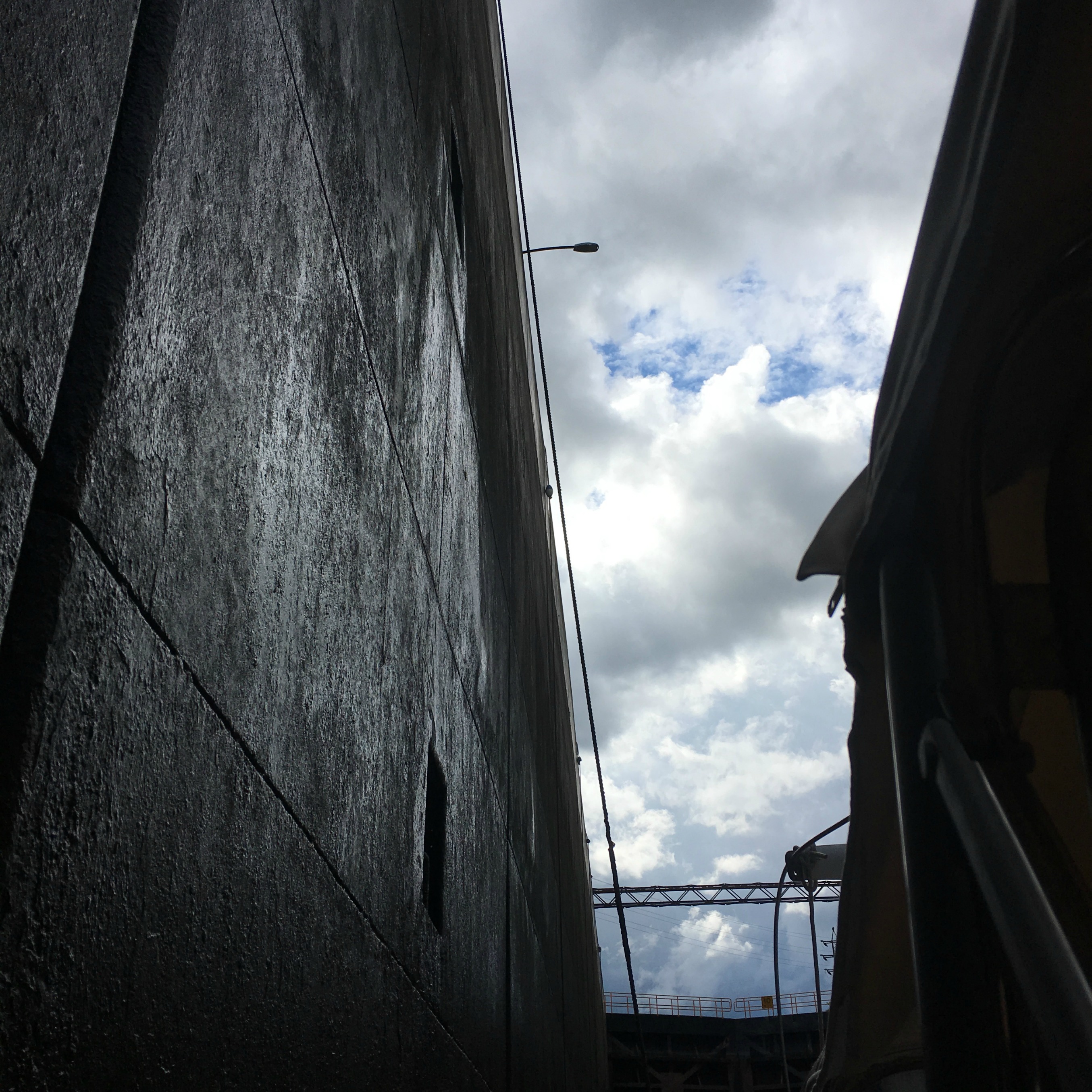
It can be something out of Edgar Allen Poe’s absinthecopated mind. In locking up, massive iron gates open to the maw of a large concrete chamber. Entering the lock often requires powering through roiling water produced by an adjacent dam spilling water across the entryway. That’s just the beginning of a Disneyesque thrill ride. If there are any crosswinds or wind from behind and you’re driving a sailboat, your boat is buffeted about like a cork. Not a good scenario for autopilot. Any other boats in the lock serve to make your entry a little more exciting. Smart boaters gird both sides of their vessels with inflated fenders or flexible fender boards to buffer against lock walls–and other boats.
Slime!
The tall, dank, often slimy concrete walls of a lock are festooned with equally slimy ropes or cables. Cracks, crevices and rough pits left behind by chunks of fallen concrete all serve as rough-edged hazards to the fenders protecting the side of the boat. Boat hooks are needed to keep the boat pushed off the wall and prevent the entrapment of fenders that can damage the lifelines, stanchions and cleats fenders are tied to, or even fatal to fenders. Some locks are like medieval dungeons—right out of the Inquisition. You almost expect to see gaunt bearded men chained to the walls attended by big hairy torturers wearing black leather masques. You don’t look up for fear of seeing Boris Karloff and Christopher Plummer in cardinal-red hooded robes peering menacingly over the top edges of the lock walls; vultures circling slowly, patiently on the thermals in the sky beyond.
From the bottom of the lock the guide lines so breezily secured at the top are perpetually wet, and often slimy. As the water churns and boils around the boat, the lines are grabbed and held by crews to stabilize their crafts. You have mere moments to grab a rope with a boat hook or your hands or run a dock line around the nearest cable, tube, pipe or other stabilizing device within reach. Stabilization is important because of the turbulence created as millions of gallons of water pours into the lock to raise your boat up to the next level.
The constant agitation is akin to being in a top-loading washing machine. Plus, it’s a wrestling match with the slippery, slimy wall lines while simultaneously pushing against that malevolent wall to keep the side of your boat from bouncing off or even grinding up the walls. The equivalent in ancient mythology would be fighting a monstrous snake or hydra with one hand around the neck of the slithery, slippery beast and a spear in the other. The helmsman has the added responsibility of keeping the boat relatively stationery to prevent ropes from being ripped out of the crew’s hands. Little pops forward or reverse are often needed to counter surges and swirls that push our 24,000-pound boat forward then backward then side to side—sometimes all at the same time. Bow and stern thrusters can be immensely helpful in keeping the boat in place. Entry to departure takes about 20 minutes, depending on the elevation, but can seem like an eternity.
The Troy lock was not our first lock up. We had a wild first lock up at the Canadian Soo Lock in Sault St. Marie a couple years ago. That lock involved strong up-your-aft winds, a large tour boat to port and a pilot boat behind that crowded us in before we had the lines secure. It was neither pretty or fun. Julie nearly put her hand into the face of a startled tourist while trying to keep our 37-foot Gaviidae away from the sides of the tour boat. We still talk about it, so that tourist is probably still talking about it, too.
For all our misgivings, the Troy lock was easy and uneventful. I was at the helm while Anne fended off from just aft of the bowsprit; Julie posted amidships. We motored the remaining few miles to Waterford to find a tie-up along the city wall before the first Erie lock. We initially tied up along the high concrete wall behind a dozen or so assorted trawlers, power boats, a tugboat and a couple of sailboats. Once we got registered with the city dock manager, we found small space adjacent to the pump-out dock that would let us get shore power. We wanted a shore power hookup so we could get the forward air conditioner running for what promised to be a sultry evening.
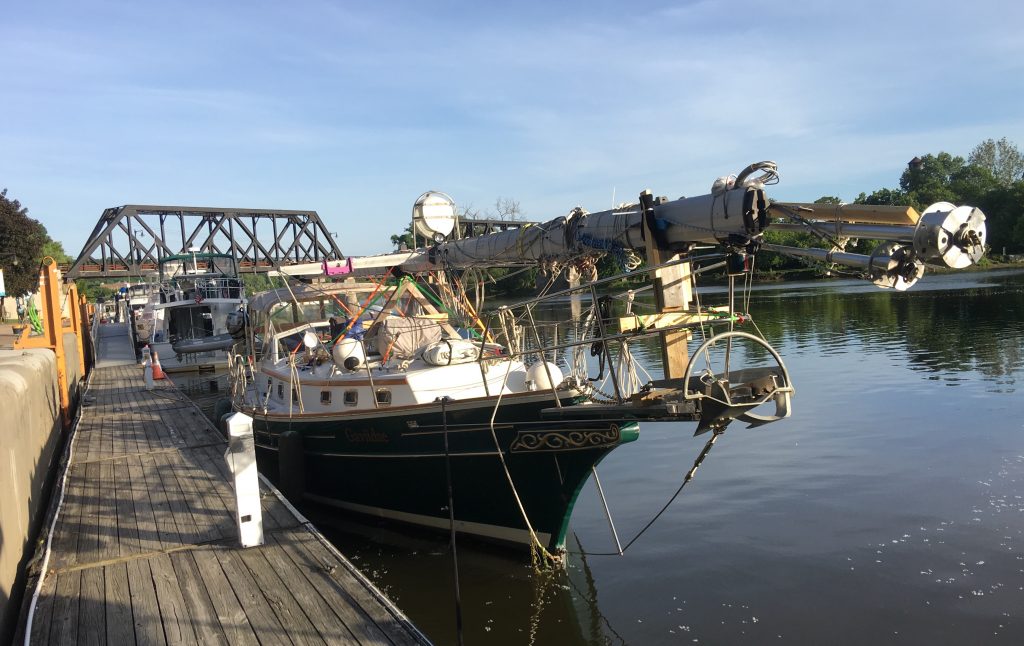
And the Engine Sang Do-Wah-Don’t
We quickly discovered another reason to hook up to a shore power station: The starting battery was unable to start the engine! Despite having the alternator on all day, which should have charged up both the starting battery and the house bank. As it was, we were forced to combine the house bank with the starting battery to start the engine to move the boat forward to get to shore power.
Once we were tied up and connected to shore power, we contacted the nearest boat store to try to find a replacement solenoid. We were told by the marine dealer they did indeed have a solenoid for us. All we needed was get to store—about 20 miles away. The next morning, while I was pulling the wrecked solenoid from the bowels of hell in the forepeak of the boat, Julie and Anne procured a rental and drove to the chandler.
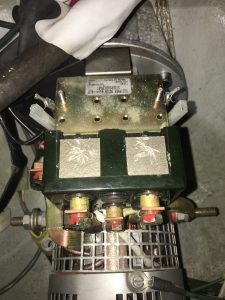
Now this was not my first foray into the narrow and awkward confines where the bow thruster motor is located. I had the pleasure of burrowing into that special corner of hell back in Rhode Island when I pulled the entire motor out because the brushes were shot. In the process, I pulled a muscle in my back that hurt like hell for over a week. This time all I had to do was disconnect and unbolt the solenoid from the bow thruster motor housing in the farthest reaches of the Black Hole where the bow thruster is mounted. If there is any justice in this life, there is a very special place in Hell awaiting the person who designed this set up. I’m sure I was scant inches from the grasp of Beelzebub as I poked and probed with wrenches in spaces too small to get more than a fractional turn. It was, of course, hotter than blazes, to boot.
I did not get the damaged solenoid disconnected until after Julie returned with its replacement. It was, of course, not the right solenoid. The marine store–very prominent in the area—not only sold her the wrong solenoid, they sold us a used solenoid as new!

They took the solenoid back—with apologies, but their incompetence cost us a car rental and a day of our time. We called the distributor and ordered the right item. We also let the distributor know about the way we were deceived by their dealer of record in the area.
Rather than wait two days to get the solenoid shipped to Waterford, we decided to start our trip up the canal without the advantage of a bow thruster. We arranged for the distributor to ship the solenoid to the Schenectady Yacht Club—our destination for our first day on the Erie Canal. We hoped it would arrive in a timely manner. But first we had to get through six locks to get to Schenectady without a bow thruster.
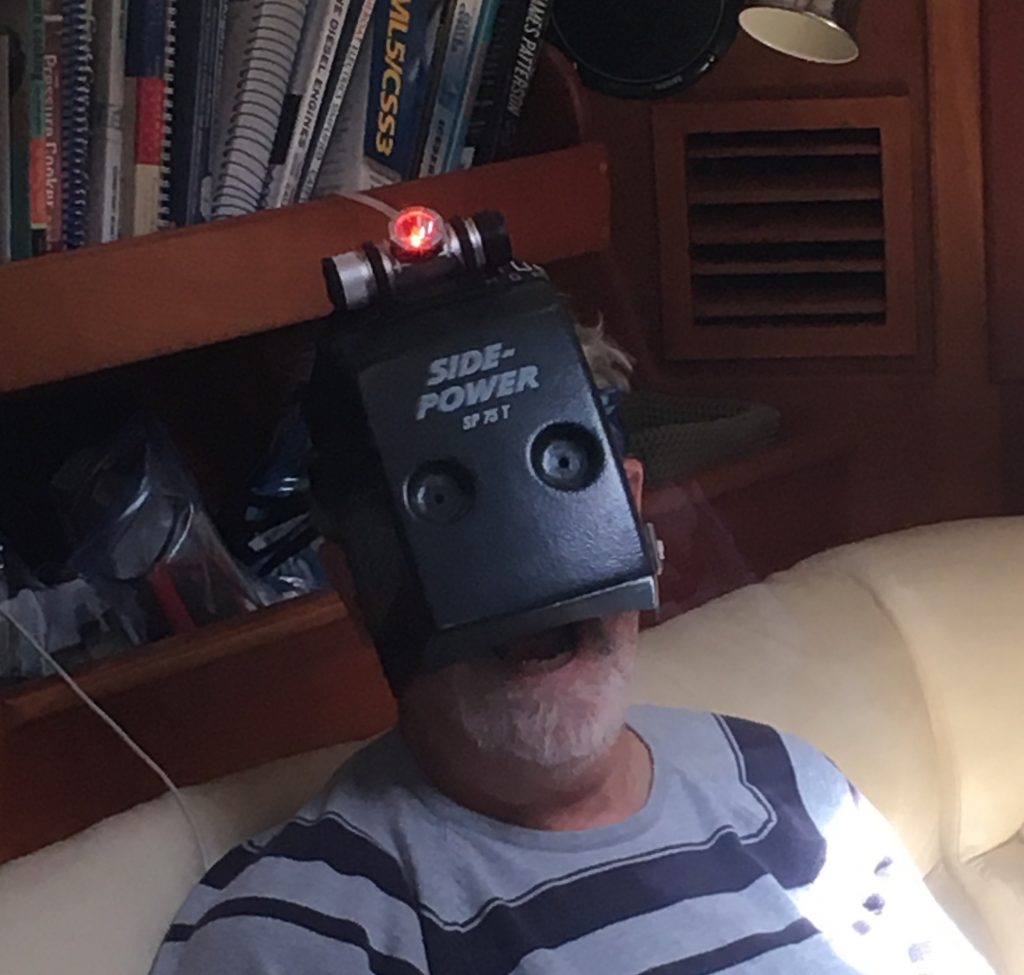
We would leave the next day.
##
June 14, 2017 Waterford NY 42°47.258’N 73°40.790’W 296.0 Nautical Miles

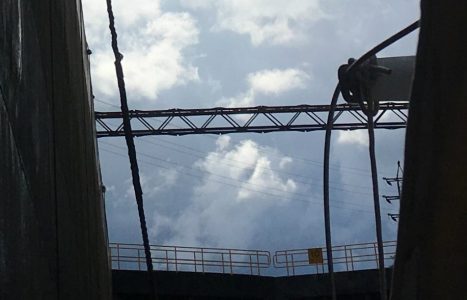
Locking up sounds about 10,000 times scarier than driving in Toronto, which I’m afraid to do! Glad you made it! Love you guys.
Hope your recovery is improving – we’ll keep trying to give you appropriate (distracting) reading material! Love you! Give Lucy a belly-rub.
Want more, Daniel and Julie!
Working on it! Thanks Ilona!